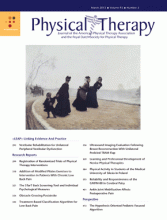Abstract
Background The Gross Motor Function Measure (GMFM-88) is commonly used in the evaluation of gross motor function in children with cerebral palsy (CP). The relative reliability of GMFM-88 has been assessed in children with CP. However, little information is available regarding the absolute reliability or responsiveness of GMFM-88.
Objective The purpose of this study was to determine the absolute and relative reliability and the responsiveness of the GMFM-88 in evaluating gross motor function in children with CP.
Design A clinical measurement design was used.
Methods Ten raters scored the GMFM-88 in 84 children (mean age=3.7 years, SD=1.9, range=10 months to 9 years 9 months) from video records across all Gross Motor Function Classification System (GMFCS) levels to establish interrater reliability. Two raters participated to assess intrarater reliability. Responsiveness was determined from 3 additional assessments after the baseline assessment. The interrater and intrarater intraclass correlation coefficients (ICCs) with 95% confidence intervals, standard error of measurement (SEM), smallest real difference (SRD), effect size (ES), and standardized response mean (SRM) were calculated.
Results The relative reliability of the GMFM was excellent (ICCs=.952–1.000). The SEM and SRD for total score of the GMFM were acceptable (1.60 and 3.14, respectively). Additionally, the ES and SRM of the dimension goal scores increased gradually in the 3 follow-up assessments (GMFCS levels I and II: ES=0.5, 0.6, and 0.8 and SRM=1.3, 1.8, and 2.0; GMFCS levels III–V: ES=0.4, 0.7, and 0.9 and SRM=1.5, 1.7, and 2.0).
Limitations Children over 10 years of age with CP were not included in this study, so the results should not be generalized to all children with CP.
Conclusions Both the reliability and the responsiveness of the GMFM-88 are reasonable for measuring gross motor function in children with CP.
Footnotes
Both authors provided concept/idea/research design, writing, data collection, project management, and facilities/equipment. Dr Ko provided data analysis and clerical support. Dr Kim provided study participants, institutional liaisons, and consultation (including review of rapid proof before submission).
The authors express their gratitude to the children and families who participated in the study. Special thanks go to the pediatric physical therapists in the Department of Rehabilitation Medicine, CHA Bundang Medical Center, CHA University, who administered the assessments for the study.
Approval for this study was granted by the Institutional Review Board of CHA Bundang Medical Center, CHA University.
- Received November 4, 2011.
- Accepted November 2, 2012.












